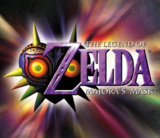Majora's Mask breaks the mold set by other Zelda games, and manages to do it in an astounding way.
Majora's Mask is a direct sequel to Ocarina of Time, happening less than a year after the end of OoT. Link is riding is noble steed, Epona in the woods when he is attacked by a mischievous little boy who is known as the Skull Kid. The Skull Kid dawns the magical Majora's Mask, which twists the wearer into a state of insanity, which causes the Skull Kid to reek havoc and steal Link's Ocarina. Link gives chase to the Skull Kid, only to be transformed into a deku shrub, and run into a mask salesman, from who the Majora's Mask was stolen. The salesmen asks Link to return the mask before the end three days, and in return for the mask he will return Link to human form.
Link now has to scuttle his way across Clock Town doing various activities inside before three days time so he may access the Clock Tower to battle the Skull Kid to retrieve the stolen Ocarina, the key to Link's recovery. Link quickly finds that just getting the mask back is the least of his worries, as the moon is en route to crash directly into Clock Town at the end of the third day. Link must battle the Skull Kid as a deku, retrieve the Ocarina, and play the Song of Time to reset time to beginning of the first day so he may be restored to human form. Then, his journey to take back the Majora's Mask begins. To be able to fight the Skull Kid, Link must have the 20 happy masks spread across the land, and sacrifice them to the moon so he may acquire the mighty Fierce Deity Mask.
In Majora's Mask, Navi is nowhere to be found. Link instead travels with one of the two sprites that traveled with the Skull Kid, who was abandoned by the Skull Kid. Mant other characters are also absent, such as Zelda and even Ganondorf. The gorons and zoras do return however, and Link is eventually able to transform into both of these races at will, after acquiring the respective masks. Some characters do return, such as Romani, the rancher who always manages to find Epona.
Gameplay is more or less unchanged from previous Zelda titles for the basics. Link has his sword and shield, and his ranged weapons and bombs. The temple formula is unchanged as well, meaning that Link goes through to fight a mini-boss, then gets an item, then fights the main boss. The real saving grace keeping Majora's Mask different is the happy masks. The happy masks all have different effects. Some make Link run faster, some make him invisible, and some can make him explode. How you use these masks is up to you, and few are required in the dungeons, but all are required to finish the game. Experimenting with the masks is an enjoyable thing, and figuring out the best way to use them in battle can be a key to victory.
The graphics are possibly the best on the N64. The different and darker art style allows the game to still be playable and enjoyable today. While the graphics are nothing special, they get the job done, and they shouldn't deter anyone from enjoying this game. Sound effects are nothing special, but the music is excellent. One of the better sound tracks from a Nintendo game, which does mean something.
Majora's Mask is what I wish games of today were: different. No other Zelda game has ever tried to be stand out as much as Majora's Mask has. While the general gameplay is the same and graphics might not please everybody, it is still one of the greatest games I will ever play. Majora's Mask breaks the mold set by other Zelda games, and manages to do it in an astounding way.

